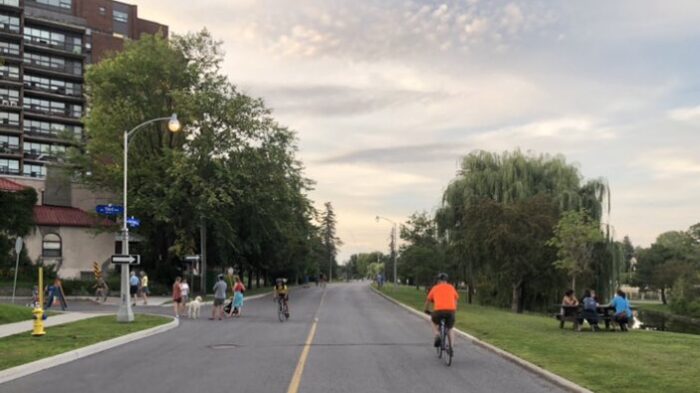Recently, Mayor Mark Sutcliffe expressed his opposition to the National Capital Commission’s Active Use program and the Queen Elizabeth Driveway in particular, citing low usage and added traffic in adjoining streets.
Since the mayor didn’t cite any data, we thought we would.
What follows is a simple series of calculations that show just how little road space and time the closure of QED to vehicles actually represents.
Let’s start with the length.
- QED from Laurier to Preston—essentially its entire length—is 5.6 km
- QED from Somerset to Fifth—the Active Use Program—is 2.06 km
In short, 36.8% of the QED’s length is used for the NCC’s Active use program. That’s not a lot. (Compare that, by the way, with the fact that Ottawa has over 6,000 km of roads available to motorized vehicles. That’s right, we’re talking about a third of 1% of available roads—not a lot.)
Now let’s do duration. The Active Use program has a few different phases
- From May 13 to June 25, it’s only closed to vehicles weekends (14 days) and holiday Mondays (1 day), so 15 days
- From July 1 to September 4, it’s closed to vehicles all week, so 66 days
- From September 9 to October 9, it’s back to weekends and holiday Mondays, so 11 days
In short, QED is reserved for the Active Use Program 92 days in 2023.
But of course, the Active Use program isn’t 24 hours per day; it’s only 8 am to 8 pm. So the total hours that it’s closed to vehicles is 1,104 h (92 days for 12 hours per day). Given that there are 8760 hours in a year, that’s 12.6% of the total hours in 2023 that QED is closed to cars.
Die-hard car-ists will object that not all hours are created equal: people are more likely to want to drive on QED during daylight hours, for example. Fine. If we erred on the conservative side and assume these are 12-hour days, that percentage rises to 25.2% of daylight hours in 2023—one quarter.
Here’s another way to look at this: 36.8% of the length of the QED is reserved for 12.6% (1104 hours) of the total hours per year (8760 hours) for the Active Use program, which in turn amounts to 4.6% of the length-day fraction (36.8% x 12.6%) of the QED reserved for the Active Use program in 2023. 4.6% percent isn’t a lot. The rest of the time (95.4%), it’s open to vehicles.
If again we want to sustain the drivers’ objection that not all hours are created equal, 36.8% of the QED is reserved for 25.2% of the total daylight hours (8 am to 8 pm) for the Active Use program, which is 9.3% of the length-daytime fraction (36.8% x 25.2%) of the QED reserved for AUP use in 2023. Even here, 9.3% really isn’t a lot. The rest of the time (90.7%), it’s open to vehicles.
In other words, Mayor Sutcliffe is opposing a 5% to 10% length–time fraction use of the QED for the Active Use Program, when motorized vehicles have 90% to 95% of the QED length-time fraction for their use throughout the year. And again, this represents less than a third of 1% of Ottawa’s road network.
Even if we just take the section of QED from Somerset to Fifth—the Active Use program—the mayor is opposing 12.6% of the total hours per year, or 25.2% total daylight hours. Motorized vehicles still have 74.8% to 87.4% unrestricted use of that portion of the QED over the course of the year.
The NCC counted 126,000 people using QED during the Active Use program last year, and this year will likely be similar. Why oppose all this use of QED for such a small fraction of time?
It’s also strange that the mayor would seize on one of the few routes in Ottawa that both have ample space for comfortable riding and are free from the danger posed by vehicles.
To find out more about the mayor’s opposition and why it’s wrong-headed, check out this blog. We also provide contact info to urge the mayor to begin supporting active transportation and fighting climate change.

